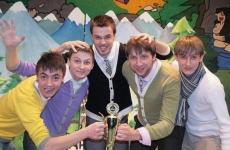Natural attractions of Donbass. The place of Donbass, which we do not know about (photo). Presentation - Amazing World of Nature Donbass
Those who are challenged from the bustle of large cities, noise of roads and mobile phone calls, in search of new sensations want to enjoy the rest in nature, you can advise visit landscape parks.
In the Donetsk region of such unique corners of the untouched nature six. Each of each of them has its own highlight, but the main thing is that you can see here - unique natural complexes and objects that are preserved in pristine form.
- Regional landscape parks are environmental recreational institutions of regional or local importance. On the one hand, a natural diversity remains here, on the other hand, they are open to tourists and holidaymakers, "says the head of the Department of Natural Reserve Territories, Forestry and Bioresources of the Department of Ecology and Natural Resources by Donetsk Regional State Administration Vitaly Zalevsky.
Of course, the conditions for visiting unique natural attractions should be noted, special.
- When creating landscaping parks, zoning territory is carried out, as a rule, these are four zones: protected, adjustable recreation, stationary recreation and economic. Accordingly, the modes of visiting each of them differ. For example, in the reserve - more strict mode of visits and quite limited. Traditionally, researchers come here. In the zone of adjustable recreation, short-term rest is possible. There are environmental trails, recreation places are equipped: it is arbors, viewing platforms, bridges. In the stationary recreation places there are campsites, holiday homes, tourism. And in economic zones, economic activities are allowed in compliance with the general environmental requirements. After all, sometimes arable land fall into the territories of parks. Then the organization's project is planned that here in the future there will be organic agriculture without the use of pesticides and chemicals, "says Vitaly Dmitrievich.
Hunting on the territory of landscape parks is prohibited. But if there are water bodies, then it is often easy to visit fish.
Regional parks in the Donetsk region appeared relatively recently - 13 years ago.
Beauty Yuga
One of the first regional landscape parks is "Meetida". The uniqueness of this natural attraction lies in her feathered inhabitants - it is here that the colonial settlement of the chain birds on the arrow of the Kosy curve is located. Among 250 species of birds about 100 are nesting here. By the way, for several years now the park is experiencing reorganization. Back in 2009, the National Park was created on the basis of the regional park.
- It is now undergoing large-scale work on the delimitation of the territory of the regional landscape park and the national natural, - Vitaly Zalevsky notes.
In 2004, a landscape park Polovtsaya steppe was included in the regional landscape park "Meetida". Interesting steppe landscape of the pristine steppe, dozens of red-born plants - that's what visitors can see here.
Fascinating landscape
One of the most famous landscape parks of the region is perhaps "Kleban-Bull". Here you can walk for hours for hours, admiring petrified trees, ancient rocks, which came to the surface, rare plants listed in the Red Book.
Raisin Park - petrified trees - Araucaria. Today they can be found in South America, in Australia and on the islands of New Caledonia in the Pacific Ocean. And once they grew in our territory. According to the appearance of the fragment of the petrified tree, there is little different from the newly scaled pine trunk. However, the unusual severity, sparkling quartz crystals say that it is a stone. Some of the fragments have retained not only the shape, but also the inner structure of the plant.
In addition to tourist trail with six survey sites on the ridge of a hill, decorated with stone sculptures, wooden bridges, in the landscaped park includes territories of tourist sites and campgrounds on both shores of the reservoir.
Mecca for climbers
Just forty kilometers from the miner's capital, the Landscape Park "Zuevsky" spread. Here is a natural clodder, one of the best in Ukraine. Here, not only professionals can be engaged in the extreme sport, but also newcomers. The attention of tourists attracts an artificial waterfall "Wasply", having 52 steps. The unrivaled look opens in front of visitors with Zui Mountains.
Preserve steppe
Regional landscaped park "Donetsk Kryazh" is Askania-Nova in miniature. Flora admires its diversity and harmony, fauna exceeds all expectations. Visitors can see the steppe, which alternates the arrays of artificial plantings and bairan forests. On the territory of the park there is a Kurgan Sur-Tomba, one of the highest points of Donetsk ridge. After the Great Patriotic War, a memorial complex was created on Saur grave.
Unusual mosaic
"Kramatorsky" Regional landscape park is one of the youngest in the Donetsk region. It consists of four completely different sections: "white", "Belokuzimnik", "Pchelkinsky petrified trees", "Kamyshevakha".
"White" is a virgin steppe. There are numerous exits to the surface of the chalk breeds. And on the hills there are picturesque artificial coniferous arrays.
The unique feature of the Pchelkinsky Penal Trees section, located near the city village of Pchelkino, are the places of the Crimean Pine. There are exits of petrified trees of a coal age of over 200 million years.
"Kamyshevakha" is represented by forest arrays from oak, ash, maple, elm and linden. There is a beautiful swan lake, in which swans-hype live.
The business card of Belokuzminovsky Plot is a geological monument of Nature "Rock-like exposure of the upper chalk". The view of this mountain can not not impress.
Treatment and rest
No less interesting and landscape park "Slavic resort". True, it is not in the jurisdiction of the city. It is located on its territory the monuments of the nature of state importance - the unique salty lakes of Karst origin - the blind and repove, the ornithological reserve "Priozenny", where more than 70 species of birds nest are nesting, among which there are rare and endangered species. In addition, hospitable institutions are located on the park.
For more information about the natural attractions of the Donetsk region, read the nearest rooms of the newspaper.
Daria Kyosdeoda
6th grade. Citizenhood lesson.
SUBJECT. Nature features Donbass
The purpose of the lesson: remind students about the basic natural features of the Donbass; to point out the value of nature for a person, its role in the development of our region, a careful attitude towards natural wealth; Brief interest in the historical past of Donbass.
DURING THE CLASSES
I.. Organizing time.
II.. Actualization
Teacher: On the nature of the Donbass, its geological past, a characteristic relief, climate, water bodies, a specific plant and animal world, the principles of rational use of natural wealth in our region will be discussed at today's lesson.
III. Teacher's story
The ancient eastern legend of the fictional traveler named Kidz - instructive:
"Once," the Kidts says, "I passed the streets of a very ancient and amazing crowded city and asked one of the inhabitants:
How long have your city been founded?
Indeed, this is a great city, "the town dweller replied," but we don't know with what pore it exists. "
Five hundred years later, I was again passed on the same place and did not notice the slightest traces of the population, I asked the peasant, mowing the grass on the place of the previous capital, was long destroyed.
Weird question. He answered. - This land never differed in anything from how you see her now.
But didn't you have a rich city here? - I asked.
Never, "the peasant replied me," at least we have never seen him, and our fathers didn't say anything about it.
Returning after another five hundred years, the Kidts found the sea in the same place, and on the shore of him - the crowd of fishermen, who for a question, has long been covered with water long ago, they answered that there was always a sea in this place ... "
Yes, the legend has a deep meaning. The appearance of our planet all the time changes under the influence of various factors: uneven heating of the surface of the earth by sunlight, winds, rain, plant development and animals. But these changes occur extremely slowly, and in everyday life people do not notice them.
Our region also knew many changes and the nature of our region, despite his features amazing and beautiful. In nature, everything is interconnected. And a person who is also associated with the environment is part of nature. If nature suffers, the person himself suffers. Therefore, he himself should know and take care of nature.
Reserves, reserves, botanical gardens help the preservation of rare and endangered species of plants and animals.
In our region there are places that reflect the vegetable and animal world of the whole Donbass are national parks, reserves, landscape parks. Please note: (Demonstration of images)
1. The National Park "Holy Mountains" are located on the territory of the Slavic and Red Policy districts. Created to preserve the landscapes of Donetsk ridge with its unique natural complexes. In the people from time immemorial, this land is called holy. Here, according to the legend, the powerful Svyatogor argues, how to wise peace under the Cretaceous Rocks, you watched Ilya Muromtsu.
Here is one of the most ancient DNRs in our state of the Svyatogorsk Monastery. From all over people go to him. Some - on the bow, others - to the cure. Picturesque chalk mountains with numerous caves. Even in multi-fashionable frosts, these caves retain a normal positive temperature, so the monks used them as celi. Here you can meet amazing plants: the median is unclear, the horizon of the spring, sleep-grass, the valley, the unhapable bundle, scum. Brown vegetation in lakes and swamp: white water lily and water lily yellow, rogol, waterfronts. Only here there is a water fern, salvia floating, aloevid television relazes, as well as an insectivore plant - ordinary bubble. She has no roots, and on the leaves there are bubbles at the ends. With their help, the predatory plant is engaged in fishing insects. Oaks and chalk pines are great value. It is preserved in the mountains of Artem. The age of oaks is 200 - 300 years, oaks - giants have a diameter of 81 cm, and a height of 25 m. Many of them need protection. Diverse animal world: wild boars, goats, spotted deer, moose, squirrels, woodpeckers, nightingales, cuckoo, frozard, kododon.
On the territory of our region there are two reserves: the Khomutov steppe and stone graves (film demonstration).
Khomutovskaya steppe - A unique reserve is located in the Novoazovsky district near the village of Khomutovo. Its area is 1030 hectares. This is the first reserve in the Donbas and the most significant in the area. The reserve has great scientific importance. He became a benchmark for studying soils, vegetation, animal in the public. There are 560 species of plants here, among which are 50 rare, and 15 are listed in the Red Book. Here we grow up: Lessing Kickl, Grannya Ural, Tulip Schlenka, Karagach (Dereza), Goose Bow, Rogoz, Cane, Harbon Water, Voronets.
Stepnomy give the unusual stone women. They are on the territory of the reserve more than 20. There is here and the museum created in 1957. People's Artist and Director Sergei Bondarchuk removed a wonderful film here on the work of A.P.hekhov "Steppe".
Stone graves located on the territory of the Volodarsky district and continues in the Zaporizhia region. Its area 311 hectares on the territory of our region and 100 hectares in the Zaporizhia region. Huge boulders 75 - 100 m tower over Donetsk Stepha. Where did these granite gigar appear in the steppe? Scientists believe that about 2 billion years ago, this unique corner has occurred in the territory of the current priaudation. Since 1947, he became a state reserve. The steppes here are varnoping-nice. In the reserve, lescing hobs grow, Kovyl - Hair, Ticachak, Sage Dynodesh, Veronica Steppe, Zepture, Stranny, Rolling-Field, Chabret, Yarrow Naked, Rosehip, Turn. Annually, students of universities are held here: biologists, geologists, historians. From early spring and to late autumn, thousands of tourists are visited.
Regional Park "MEATIMA" Educated on June 30, 2000. Under the protection there are 13 thousand hectares of the territory of the priazia and 13 thousand hectares of the Azov Sea. This reserve is adopted in the international organization EVROPARK. "MAOTIMA" so the Greeks called the Azov Sea. There are about 60 monuments of archeology. Rich vegetable and animal park. 49 species of mammals were registered, 7 species of reptiles, 5 types of amphibians, 79 species of fish, 1500 species of insects, but the world's most diverse in the park. Here you can meet the steppe beauty of the DROF, black stork, swan-hipun, mountain grit, silver Martha, Chernogolovaya Stryutun.
IV.. Fastening material
Just as the rules of behavior, on the streets and roads, there are rules for human behavior in nature. Let's make them together and write them to know them, remember and most importantly do. (Together the guys group account for behavior in nature).
Approximate option
Take care and guard the vegetable and animal world of your native land.
Gathering on a hike, on a tour or just on vacation in a natural zone, get drunk in advance about the bone accessories. Do not destroy young green plants, collect only sunyak for the fire.
Strictly follow the rules of fire safety in the forest. Do not throw tight matches, do not branch fires in fire hazardous places.
Leaving, be sure to fill with water or pour the burrier ground.
Do not grow wild flowers, otherwise they will disappear with meadows, swamps, forests and water bodies.
Follow the wise saying: in the vase there should be only what is grown by the hands of a person, and what is created by nature should remain in it.
Take care of animals. Do not catch wild animals and birds. Remember that the content in the captivity of wild animals in most cases leads to their death.
Do not destroy the bird nests, do not ruin the anthills, do not roll the holes of animals.
Do not attract in nature. Noise disperses animals and birds. The quieter you behave in nature, the greater hear and see.
Do not pollute nature. In the campaign, in the parking lot and in the camp, all unnecessary items and waste assemble into cellophane coraces and take in the nearest trash can, urn or scream into the ground.
Take care of springs, wells and reservoirs: do not throw garbage in them, do not drain the sewage. Remember that 1 liter of gasoline is able to spoil 10 thousand liters of drinking water.
Do not wash the cars and motorcycles in the reservoirs. Leave the places of your routes so that you wanted to visit them again.
V.. Homework
Examine the material obtained, prepare a message about other natural monuments of the Donetsk region. Botanical Garden in Donetsk, River Seversky Donets, River Calmius, Donetsk Lakes, Donetsk resort areas.
I want to dispel the myth that Donbass is only mines and plants that there is absolutely nothing to look. In fact, there are amazingly beautiful places comparable to the Crimea, Ternopil, Poltava, Cherkaschina.
Beautiful chalk mountains, steppes, flowering meadows, unique monuments of nature.
Below are briefly described four such places in the vicinity of Kramatorsk.
1) River Seversky Donets
2) Alekseevo-Druzhkovka. Stone trees. (Konstantinovsko-Druzhkovskaya Anticline)
3) Regional Landscape Park Kleban-Bull
4) Cretaceous cliffs in C. Belerokuzminovka
River Seversky Donets
Seversky Donets (Ukr. Skivsky Donets, Ancient Greek. In Ptolemia Tanaid, Tanais, Italian. Tang, Old Russian. Great Don, Donel, Don) - River Southern Eastern European Plain, flowing through Belgorod and Rostov region of Russia, as well as Kharkiv, Donetsk region and the Lugansk regions of Ukraine, the right (largest) don's influx. The fourth largest river of Ukraine and the most important source of fresh water in the east of this country. Sometimes the Northern Donets is also called, in the XVII-XVIII centuries - Northern Donets. Wikipedia
Seversky Donets is an amazingly beautiful river, I recalled Psels and Ros places. Not very fast flow, picturesque shores, a lot of cubes, there are white lilies in some places. Great place for capeats and parking on the shore. The only thing that is near large cities all the shores are busy recreation databases and private possessions.
Seversky Donets
White Wagtail (Motacilla Alba) and tourist parking on the shores
Typically, Donbass landscape with tercrions.
Alekseevo-Druzhkovka. Stone trees.
Here in the former career for the extraction of refractory clay are the remains of petrified trees, the araucaria, which is about 250 million. Currently, similar trees have been preserved in South America, in Australia and New Caledonia Islands.
A very beautiful meadow spread around the career.
Tree we saw only one, the rest of smaller pieces, the locals were torn to souvenirs and to the finish of fireplaces.
Pretty flat terrain in the area is cut by several ravine-made clay mining careers
Career slopes gradually overgrow
There is no steppe and meadow around the year
Stone outputs on the slopes
Actually, what is worth going there. Petrified Aurucaria
This giant can be dragged only with the help of an lifting crane, because it remained on the side of the career
Sand-clay slopes
Gorgeous place to play in the Indians. Amazing but around quite clean, pleases the absence of garbage
More Ambonges Career
View of the quarry on top
Surround meadows
More dispersed
Some kind of pizhma and cornflowers (genus Centaurea), who have never seen
I look very beautifully the clearing of these cornflowers, it is already blooming at the top, and a little lower - more buds
Veronica Colosity (Veronica Spicata) and Hatum Thuringan (Dog Rosa) (Lavatera Thuringiaca)
Ordinary Blueberry (Blue Rushes) (Echium Vulgare) and Ordinary Pijm (Tanacetum Vulgare L.)
Pigeons fields
Korovyan (Verbascum) and Sage (Salvia)
Scabiosa (Scabiosa) and a vague (MyLabris Variabilis) Deadly Yellow Dryer Flowers (Senecio)
Field Consolid (Royal Dolphinium) (Consolida Regalis) and Zipnik Barley (Zheleznyak) (Phlomis Pungens Willd.)
Zopnik thicket
Podalirius (iPhiclides Podalirius L.)
Of the interesting creatures also saw Cristata Crested Larks, in Kiev they appear only in January-February.
Kleban-Bull
The regional landscape park "Kleban-Bull" is located on the territory of Konstantinovsky district of the Donetsk region, the total area of \u200b\u200bthe park - 2142 hectares. The territory of the park is a picturesque mountainous area on both shores of the Kleban-Byksky reservoir, which is in the mouth of the river a bull (tributary of the river Krivoy end).
This area is closely related to the history of the Troops of the Zaporizhia and its state - the glorious Zaporizhia SECHE. Almost 1500 in the royal directions issued by Zaporizhia's tric on the borders of the Cossack Valivity, the name "River River's batch" occurs, since 1600 - "Clebina", and from 1720 - "Kleban-Bull".
The one who believes that the name of the reserve and the inflow of the river is somehow connected with the bulls, which were allegedly bred in this area. In fact, the combination of words of Kleban bull means approximately the same as "pits". The fact is that the entire territory of this fleet of 200 million years ago was the bottom of the Perm Sea, as evidenced by the prints of mollusks and a sewer on sandy stones.
Very picturesque place, visible parking with tents on that shore
At the bottom of S. Kleban-Bull, fields and meadows
Panoramic
Belokuzminovka
Geological monument of the nature of local significance. Located in the Donetsk region in Konstantinovsky district near the village of Belokurovnik. The status of a nature monument was assigned to the decision of the regional executive committee No. 310 on June 21, 1972. Area - 0.35 hectares.
The age of the chalk mountain is 90 million years. The mountain consists of deposits of the last period of the Mesozoic era, which were formed in pure warm marine waters from small marine organisms with a lime skeleton. Vertical white-gray rocks are distinguished in the rock, the eastern edge of the mountain is broken with white-gray cliffs. At the foot of the mountain there are multiple niches, potholes, large and small caves. Among the Cretaceous rubble often meets flint.
The exposure of the chalk rises to the height of more than 25 meters. On the eastern outskirts of exposure is a single sword mountain.
Stopping and rocks are completely devoid of vegetation. The vegetation consisting of meadow and dubbed plants is only on the edge of the scales, they grow here: buttercups, clover, geranium meadow. In the clefts and niches at the vertices of the rocks there are approach of the rifle.
The parking of a primitive person with a flithing workshop mined in this mountain was found near the rock-eyed outcrop of the upper chalk.
Since 2004, the scalrent exposure of the Upper Chalk is part of the Kramatorsky Regional Landscape Park. Wikipedia
View of the rocks from Belurovnikov
Near the cliffs Small lake and chalk hills
Official plate and slightly less official
Circle flowering meadows, cows and idyll generally
Distribution
Once again, the meadows, cows and hills
Nona (Nonea) (possibly N. Russian (RUSSICA), but MB and dark brown (N.Pulla DC) Some believe that this is the same) and the ocherian ordinary (motherboard) (Origanum vulgare)
Ordinary flaxwill (Linaria Vulgaris) and Kermek Tatar (narrow-seater Tataric) (Goniolimon Tataricum)
Clam Blum and Rocks
In the rocks a lot of silicon enclosures
These silicon fragments are all sleeping
Donetsk ridge smoothly descends to the Azov Sea, changing the absolute marks of the height of the earth's surface from + 300m to 0. At the main Debaltsev-Ivanovo watershed, the highest rift mark - 367 m. The maximum height amplitude in the area reaches 200 m.
Svyatogorsk
The nature of the Northern Priazia and Donetsk elevation is diverse. Azovia is typical for the Ukrainian steppe, and the hilly hills of the Donetsk ridge is raised by deep beams with the streams of streams and robes.
In view of the stormy business activities, almost all the streams built small and large ponds as well as reservoirs, of which the largest - Olkhovskoe, Nizhnefrynskoye, Kurakhovskoe, Karlovskoe, Kleban-Bykskoye, Starobeshevskoye, Uglegorskoye ... Total there are 154 reservoirs and 1011 ponds with a total area of \u200b\u200bwater 8049 hectares. Natural lakes are mainly located in the River Valley Seversky Donets.
 Park Kleban Bull
Park Kleban Bull 246 rivers belong to the pools of the Black and Azov seas in the Donetsk region, which belong to the pools of the Black and Azov seas, of which 47 have a length of more than 25 km each. The greatest river - Seversky Donets and its tributaries - a stateless end, Bakhmut, Lugan (Dona pool); Wolf River with dry and wet cadets (Dnipro pool); River Calmius, Ferrics, Kryanka (Sea Pool). Rivers - flat type, mainly snow and rain food. Balneological significance have Slavic salted lakes (repove, blind, veins) and sources of mineral waters (Dobropolyn, Slavyansk).
Donetsk region in its geographical location refers to the central steppe. The climate of the region is continental with dust-dry phenomena. Wind mass, which come from the Asian mainland and Nizhnevolzhsky steppes, determine the low temperatures in winter with cold, and in the fall and summer are dry hot winds.
The average temperature of the warmest month (July) + 26, the coldest (January) - 6. The absolute maximum temperature in July + 38, the absolute minimum in January - 36.

The relief of the Donetsk region is varied, with characteristic strong soil erosion. In places of limestone limestone (swimming pool and dry wave) and salt sediments, karst form of relief are developing. Anthropogenic form of relief - groundcock, careers, ancient mounds (burial grounds) are common.
Donetsk region has the richest reserves of high-quality coal (anthracite and coking coal), rock salt, flux and construction limestone, mergels, gypsum, refractory clays, kaolina, chalk, granite, mercury, quartzite and other minerals.
Forests occupy 4.8% of the area of \u200b\u200bthe region. Within the Donetsk grade, small deciduous forests are dominated (oak, maple, ash, birch); Along the Seversky Donets - pine bors and floodplain forests (alder, birch).
Passenger forest stripes (oak, maple, ash, white acacia, apricot) are common.
 Embankment in Donetsk
Embankment in Donetsk Modern fauna is represented in most steppe and some forest animals. There are more than 50 types of mammals (fox, hare-rusak, horsefish, tushkanchik, mice), 41 - fish (bream, Sudak, Som), 12 - reptiles (already, lizard, viper steppe), about 300 species of birds (KORSHUUS , hawk, larks, partridge, wild ducks). In the forests you can meet a fox, a badger, moose, root, boar, squirrel, hedgehog; From birds - owls, nightingale, Dyatla, Gorzlitsa. On the coast of the Sea of \u200b\u200bAzov - geese, ducks, horses.
In the Sea of \u200b\u200bAzov: Dolphin (Azovka) and 79 species of fish, of which are industrial significance: Tulka, Hams, bulls, herring, kefal, fluster, sturgeon.
National Natural Park "Holy Mountains"
The territory of the first in the left bank of the National Natural Park (NPP) "Holy Mountains", 40,448 hectares, stretched along the bed of Seversky Donets from the Kharkiv region in the North-West to Lugansk, in the East in the Slavic, Red Policy and Artemovsky districts of the Donetsk region. The park was created in 1997.
The history of the development of the nature of the Holy Mountains consists of many centuries. This is evidenced by numerous archaeological monuments (on the territory of the NPP 129 objects of archeology), which are dated to the Paleolithic to the Middle Ages, and 73 monuments of history.
The most famous monument of historical and cultural heritage - the Svyatogorsky Cave Monastery - exists, according to some versions, from the XI century.
In a variety of both typical and specific conditions, the relief of the right bank grows wide forests by age 90-110 years with the advantage of oak. In several parts of the floodplain, the oaks are preserved by age 280-300 years, while some oak instances reach400-600-year.
There are 54 species of mammals, they nest and occur during migrations about 200 species of birds, 19 species of reptiles and amphibians live. In the river, in the floodplain swamps, the lakes are about 40 species of fish. The total number of fauna representatives has up to 3 thousand species.
Of particular value are unique chalk bors, formed by the pine chalk tertiary relic, brought into the Red Book of Ukraine and to the International Red List of Nature Conservation Union.
The following nature monuments and reserves are included in the National Natural Park "Holy Mountains":
In the Slavic area:
"Mayatskaya cottage" - the largest in the Donetsk region a dubiamal array! Botanical monument of Nature of national significance.
"Poima-1" - caught oak forest, forest reserve of a local value of 590 hectares.
The tract "Pine" is pine planting of artificial origin, age of more than 50 years, the forest reserve of the local value of 527 hectares.
Monument of Nature "600-year-old Oak". A little higher laurel of the flow of the Donets, on the left bank, there is a plot of 200 - 300-year-old oaks. Most of them reach a height of 25 m and a diameter of about 80 cm, and some trees reach the diameter to one and a half meters. Here, on one of the edges, 600-year-old oak grows, the oldest in the east of Ukraine. Its parameters: height - 29 meters, diameter - about 2 meters, trunk girth - 6.3 meters.
Dendropark of Mayotsky Lesnia
In the Red Policy Area:
Vladyysh reserve - Forest in the floodplain of the River Seversky Donets, on which the Lily of the Lily Maysky, the Botanical Reserve of the local value of 43 hectares.
The reserve "Black Stallion" - the place of grieving of Chernokolnikov on the River Black Stallion, the overall reserve of the local value of 223 hectares.
"Chernetskaya" - the landscape reserve of the local value of 197 hectares. On the territory there are pine plants of artificial and oak planting of natural origin.
Lake Chernetskaya - hydrological monument of the nature of local significance.
Martinenkovo \u200b\u200bswamp - the ornithological reserve of local importance.
Weekly - Landscape Reserve Local importance: Castle and oak high-charts are located around the lake approach. Area - 197 hectares.
In Svyatogorsk:
"Pine area" is a landscaped reserve of local importance, pine plantations around Svyatogorsk, age up to 120 years old. The area of \u200b\u200bthe reserve is 686 hectares. At the 19 sessions, the Donetsk Regional Council considered the question of canceling the status of the reserve.
monument of Nature "Topol"
Regional landscape park "Donetsk Kryazh"
"Donetsk Kryaz" was created in 2000 in the territory of the Miner's and Ambrosievsky districts of the Donetsk region, the total area of \u200b\u200bthe park is 3,952.2 hectares. This is one of the picturesque places in the region. Flora admires its diversity and harmony, fauna exceeds all expectations. "Donetsk Kryazh" is Askania-Nova in miniature. On the territory of the park you can see the horse of Przhevalsky, Bizon, Noble and Spotted Deer, as well as other interesting and unusual representatives of the animal world for our region. In addition to the listed animals in the park, 152 vertebrate species, 150 species of insects, 80 species of birds coexist. Many of them are listed in the Red Book of Ukraine. For tourists who wish to admire the nature and animal world "Donetsk Growing", weekend excursion routes have been developed. The park includes specially equipped recreation areas. In the near future, lovers of an extreme leisure will be able to fly on Deltaplane and Paroplane. Conditions for this sport are excellent - hills from 180 to 250 meters above sea level. Mountain bike lovers will also be able to spend their free time with health benefits, led trails have been developed for them.





